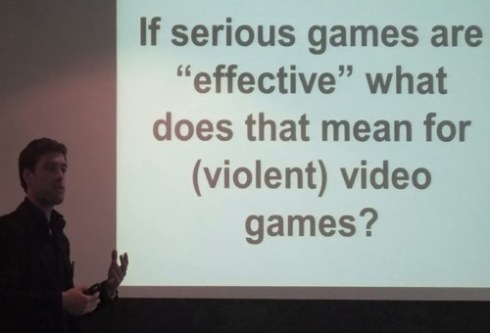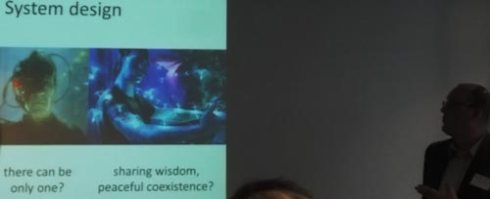 Dutch journalist and game researcher, David Nieborg is referring to a recent school shooting in the Netherlands and a newspaper heading which connected the shooting to the influence of video games.
Dutch journalist and game researcher, David Nieborg is referring to a recent school shooting in the Netherlands and a newspaper heading which connected the shooting to the influence of video games.
The discussion that followed this ended up with some insisting that ‘serious games‘ were very different to ‘video games’ and that that this is the distinction that needs to be made for the public while the other view was that ‘serious games’ should be promoted as being like all games, whether computer or not and the distinction, if there is any, is in the context and type of interaction. I agree with the second view and Joost Raessen’s presentation elaborated on this. David’s reason for mentioning this was to show how important it is for academics to use the media rather than having the media use them. If there had been statements made at the time it would be a way for academics to ‘play’ and not be ‘played’ by the media.
The expert meeting I attended on April 15th: “Play or be played” hosted at the Delft University and co-organized by the STT Netherlands Study Centre for Technology Trends + GATE Game Research for Training and Entertainment, began with four researchers giving presentations on “The Future of Serious Gaming” (a term for games developed with a purpose – such as to educate, inform or enlighten)
Moderated by Igor Mayer, associate professor of Public Management and Gaming in the faculty of Technology, Policy and Management (TPM) at Delft University of Technology, the speakers were:
Maurits Kreijveld, project manager Foresight Study Wisdom of the Crowd, STT Netherlands Study Centre for Technology Trends Maurits Kreijveld presents.
Maurits Kreijveld presents.
David B. Nieborg, game researcher and journalist; PhD-student with the Amsterdam School for Cultural Analysis, University of Amsterdam
Joost Raessens, professor of Media Theory, Utrecht University (www.gamesandplay.nl)
and
Remco Veltkamp, professor in the Department of Information and Computing Sciences, Utrecht University and director of GATE: Game research for training and entertainment
Joost Raessen‘s presentation focussed on a discussion of ‘context’ and in particular on Lakoff‘s theory of frames (link to the article, Frame Semantics which summarizes various aspects of this) and theories of family ( “us/them” framing) in connection with his own research on the various implications of serious games and video war games and in particular in connection with insights gleaned from working with Jolle Demmers (Assistant Professor and co-founder of the Centre for Conflict Studies, Utrecht University.) In particular he noted that in terms of ‘conflict’ and game strategy, games such as Dafur is Dying (where the goal is to learn about the situation and actions revolve around the perspectives of the refugee) and a typical war video game such as Call of Duty have a lot in common because both games support a ‘new wars’ frame. That is “us” vs “them” perspectives, and in this sense they share a similar ‘frame’, a similiar ideology in support of a rhetoric of conflict.
In passing, Joost Raessens mentioned a number of games and organizations involved in developing games. I’ll note some of these here:
The book, Ludoliteracy, Defining, Understanding, and Supporting Games Education by José Zagal
Books Joost Raessens has contributed to: Digital Material Tracing New Media in Everyday Life and Technology (2009)
Serious Games, Mechanisms and effects (2009)
Games for Change: who host “the Sundance of Video Games”, the Games for Change Annual Festival held in NYC in June as well as providing support, networking, and development.
Food Force: a World Food Programme (WFP) video game aimed at teaching children about the logistical challenges of delivering food aid during a major humanitarian crisis, it is set on a fictitious island called Sheylan riven by drought and war. Food Force invites children to complete six virtual missions that reflect real-life obstacles faced by WFP in its emergency responses both to the tsunami and other hunger crises around the world.
Dafur is Dying a viral video game for change providing a window into the experience of the 2.5 million refugees in the Darfur region of Sudan. Players must keep their refugee camp functioning in the face of possible attack by Janjaweed militias. Players can also learn more about the genocide in Darfur.
Casper Harteveld’s theories on game design + Triadic Game Design
Re-mission video game for teens and young adults with cancer.
And here is a link to a related article (in Dutch: gaming for rice and beans) “Gamen voor rijst en bonen” which I came across while writing this blog.

